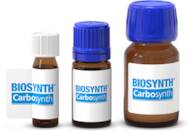Santin
CAS: 27782-63-4
Rif. 3D-CBA78263
| 5mg | Fuori produzione | ||
| 10mg | Fuori produzione | ||
| 25mg | Fuori produzione | ||
| 50mg | Fuori produzione | ||
| 100mg | Fuori produzione |
Informazioni sul prodotto
- 3-Methylbetuletol
- 4H-1-Benzopyran-4-one, 5,7-dihydroxy-3,6-dimethoxy-2-(4-methoxyphenyl)-
- 5,7-Dihydroxy-3,4′,6-trimethoxyflavone
- 5,7-Dihydroxy-3,6,4'-trimethoxyflavone
- 5,7-Dihydroxy-3,6-dimethoxy-2-(4-methoxyphenyl)-4H-1-benzopyran-4-one
- 6-Hydroxykaempferol 3,6,4′-trimethyl ether
- Centauridin
- Flavone, 5,7-dihydroxy-3,4′,6-trimethoxy-
- 5,7-Dihydroxy-3,6-dimethoxy-2-(4-methoxyphenyl)-4H-chromen-4-one
Santin is a sesquiterpene lactone that has been shown to have anti-inflammatory, anticancer, and antiviral properties. It has been used in vitro to inhibit the growth of cervical cancer cells and solid tumours. Santin also inhibits HIV replication by binding to the viral envelope protein gp120, inhibiting the binding of gp120 to CD4 receptors on T cells. Santin blocks HIV-induced syncytium formation.
Santin also inhibits the proliferation of thymocytes by inducing apoptosis and arresting cell cycle progression at G1 phase.
Santin has also been found to have an inhibitory effect on cancer cells in vivo. In one study, laser ablation was used as a treatment for prostate cancer after santin was injected into areas with high concentrations of prostate cancer cells. The result was tumor regression without any adverse effects on surrounding tissues or organs.





